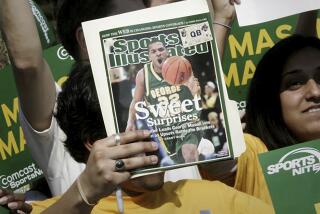Magazine Gets Back Into Swim of Things
- Share via
A year ago, Sport magazine swore off swimsuit issues, giving readers a sports calendar instead.
“There are no sexy pictures there . . . but you don’t have to hide it from your kid either,” the magazine’s editor said in a message in the January-February 1988 issue.
It must not have sold too well.
Sport’s latest issue recently hit the stands with a dark-haired model on the cover, appropriately dressed for what the headline called its “hot swimsuit issue.”
Said executive editor Kelly Garrett: “Our readers are going to be happy that Sport magazine changed its mind.”
Add Swimsuit: Sport is reviving its swimsuit issue as Sports Illustrated prepares for the 25th anniversary of its swimsuit edition.
Sports Illustrated’s initial swimsuit issue was designed to brighten up the dark days between football and baseball, when Northern cities are snowbound. The swimsuit issues have sparked protests that the sections are sexist. Despite the complaints, Publisher Donald Barr said that Sports Illustrated had fewer than 50 cancellations because of last year’s swimsuit issue.
Sports Illustrated expects to sell nearly 5.5 million copies of the 1989 issue--which hits newsstands Feb. 6--compared with 3 million for regular issues. Inside Sports has its ninth swimsuit issue on the newsstands, hoping to sell 850,000 copies, compared to the usual 500,000.
Inside Sports’ first swimsuit issue was a parody of Sports Illustrated’s, showing pretty women in swimwear with rolled-up copies of the competition’s swimsuit issue.
Said Jerry Croft of Inside Sports: “It was so well received that we decided we would keep doing our own every year.”
Last add Swimsuit: Publisher Lew Green of Sport makes no apology for the change in philosophy on swimsuit issues.
Said Green: “What we are showing here is appropriate for a young male audience. It’s part of what sports are all about.”
Pete Rose, baseball’s all-time hit leader, insists that he’s not selling autographs when he organizes shows featuring popular players.
But if you wanted to have a baseball legend’s autograph at the show Rose promoted last Saturday through Monday in Atlantic City, N.J., you had to pay for it.
Hank Aaron cost $15. Harmon Killebrew was a bargain at $7. Willie Mays cost $12. If you wanted Mickey Mantle, you had to buy a $150 “superticket,” which allowed you one signature from each of the living major league baseball players in attendance.
Still, Rose said: “We don’t make anybody pay for an autograph. We have an admission to get in the place, and the selection is there if you want it.
“It’s just like paying to get into a show. Then, if you want popcorn, you pay for the popcorn.”
Wide receiver Eddie Brown of the Cincinnati Bengals grew up in the Overtown section of Miami, and his family now lives in Liberty City, two parts of town where riots have broken outthis week.
“I’m respected in the area,” said Brown, who was an All-American at the University of Miami.
When asked if he was willing to go into his old neighborhood and try to calm things down, Brown said: “I’m not that respected.”
Quotebook
Dodger Manager Tom Lasorda, at a speaking engagement in Omaha: “I don’t think there is anybody else in this world who can be happier than me. There might be some guy in China who can tie me or something, but nobody can beat me.”
More to Read
Go beyond the scoreboard
Get the latest on L.A.'s teams in the daily Sports Report newsletter.
You may occasionally receive promotional content from the Los Angeles Times.










